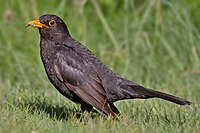
Photo from wikipedia
Abstract Avian brood parasitism is reproductively costly for hosts and selects for cognitive features enabling anti‐parasitic resistance at multiple stages of the host's breeding cycle. The true thrushes (genus Turdus)… Click to show full abstract
Abstract Avian brood parasitism is reproductively costly for hosts and selects for cognitive features enabling anti‐parasitic resistance at multiple stages of the host's breeding cycle. The true thrushes (genus Turdus) represent a nearly worldwide clade of potential hosts of brood parasitism by Cuculus cuckoos in Eurasia and Africa and Molothrus cowbirds in the Americas. The Eurasian blackbird (Turdus merula) builds an open‐cup nest and is common within much of the common cuckoo's (C. canorus) breeding range. While this thrush is known to be parasitized at most only at low rates by this cuckoo, the species is also a strong rejector of nonmimetic foreign eggs in the nest. Given their open‐cup nesting habits, we predict that Eurasian blackbirds primarily use visual cues in making a distinction between own and parasitically or experimentally inserted foreign eggs in the nest. We then provide a comprehensive and quantitative review of the literature on blackbird egg rejection studies. This review corroborates that vision is the primary sensory modality used by blackbirds in assessing eggs, but also brings attention to some other, less commonly studied cues which appear to influence rejection, including predator exposure, individual experience, stage of clutch completion, and maternal hormonal state. Blackbirds are also able to recognize and eject even highly mimetic eggs (including those of conspecifics) at a moderate rate, apparently relying on many of the same sensory cues. Although the cues involved in foreign egg recognition by Eurasian blackbirds do not appear specialized to nonmimetic cuckoo parasitism, we cannot differentiate between the possibility of egg rejection being selected by mostly conspecific parasitism or by the evolutionary ghost of a now‐extinct, mimetic cuckoo host‐race.
Journal Title: Ecology and Evolution
Year Published: 2022
Link to full text (if available)
Share on Social Media: Sign Up to like & get
recommendations!